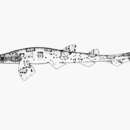ar
الأسماء في صفحات التنقل


Scyliorhinus boa és una espècie de peix de la família dels esciliorínids i de l'ordre dels carcariniformes.
És un peix marí que viu entre 329-676 m de fondària.[5]
Es troba a Barbados, les Petites Antilles, l'Hispaniola, Jamaica i, també, des d'Hondures fins a Colòmbia.[5][8][9][10][11][12] [13]
Scyliorhinus boa és una espècie de peix de la família dels esciliorínids i de l'ordre dels carcariniformes.
Scyliorhinus boa sī chi̍t khoán Scyliorhinus sio̍k ê niau-soa.
Scyliorhinus boa sī chi̍t khoán Scyliorhinus sio̍k ê niau-soa.
The boa catshark (Scyliorhinus boa) is a catshark of the family Scyliorhinidae. It is found on the continental shelves and insular slopes of the Caribbean Sea and the Gulf of Mexico, between latitudes 20° N and 9° N, at depths between 330 and 675 m. It can grow up to a length of 54 cm. The reproduction of this catshark is oviparous.
The boa catshark is a fairly small, slender but deep-bodied species that can grow to a length of about 54 cm (21 in). The front nasal flaps do not extend as far as the mouth, which has grooves on the lower lip only, and there are no nasoral grooves. The first dorsal fin has its origin just behind the rear end of the pelvic fin; there is a wide gap between it and the second dorsal fin, which is much smaller and has its origin above the posterior part of the pelvic fin. The skin is only slightly rough and the placoid scales are small.[2] The background colour of the dorsal surface and flanks is pale yellowish-brown.[3] The markings consist of a number of rather indistinct rectangular grey patches and saddles which are outlined with small black spots. Other black spots sometimes form net-like rows but these are seldom superimposed on the grey patches. There is sometimes a scattering of white spots also.[2]
The boa catshark is native to the tropical western Atlantic Ocean and the Caribbean Sea; it is found near the seabed on the continental shelves and insular slopes of the region between about 20°N and 9°N. It is a deepwater species, occurring at depths between about 329 and 676 m (1,080 and 2,220 ft).[3]
This catshark has been little studied. It is oviparous, laying a pair of eggs, with the embryos feeding on the yolk as they develop.[3]
As a deepwater species, the boa catshark lives below the depths at which commercial trawling takes place in the Caribbean region.[1] The fish does not seem to face any particular threats and the International Union for Conservation of Nature has assessed its conservation status as being of "least concern".[1]
The boa catshark (Scyliorhinus boa) is a catshark of the family Scyliorhinidae. It is found on the continental shelves and insular slopes of the Caribbean Sea and the Gulf of Mexico, between latitudes 20° N and 9° N, at depths between 330 and 675 m. It can grow up to a length of 54 cm. The reproduction of this catshark is oviparous.
Scyliorhinus boa es una especie de peces de la familia Scyliorhinidae en el orden de los Carcharhiniformes.
• Los machos pueden llegar alcanzar los 54 cm de longitud total.[1][2]
Es ovíparo
Es un pez de mar que vive entre 329-676 m de profundidad
Se encuentra en Barbados, las Pequeñas Antillas, La Española, Jamaica y, también, desde Honduras hasta Colombia.
Scyliorhinus boa es una especie de peces de la familia Scyliorhinidae en el orden de los Carcharhiniformes.
Scyliorhinus boa Scyliorhinus generoko animalia da. Arrainen barruko Scyliorhinidae familian sailkatzen da.
Scyliorhinus boa Scyliorhinus generoko animalia da. Arrainen barruko Scyliorhinidae familian sailkatzen da.
De boakathaai (Scyliorhinus boa) is een vissensoort uit de familie van de kathaaien (Scyliorhinidae).[1] De wetenschappelijke naam van de soort is voor het eerst geldig gepubliceerd in 1896 door Goode & Bean.
Bronnen, noten en/of referentiesЦе морська риба, що мешкає на глибині 329–676 м. Зустрічається у Карибському морі біля острова Барбадос, Малих Антильських островів, Гаїті, Ямайки, а також на континентальному шельфі від Гондурасу до Колумбії.
Довжина тіла самця сягає до 54 см.
Цей вид не становить небезпеки для людини. Комерційної цінності не має. Глибоководна видобуток риби в місцях проживання в даний час відсутній. Міжнародний союз охорони природи оцінив статус збереження даного виду як «вид з найменшим ризиком»[1]
Scyliorhinus boa (Goode и Bean, 1896)
Ареал Охранный статусКарибская кошачья акула[1] (лат. Scyliorhinus boa) — малоизученный вид глубоководных морских хрящевых рыб семейства кошачьих акул отряда кархаринообразных. Эндемик Карибского моря. Максимальный размер составляет 54 см[2].
Впервые вид был описан в специальном бюллетене Национального музея США в 1896 году[3]. Голотип представляет собой неполовозрелого самца длиной 15 см, пойманного в у берегов Барбадоса на глубине 366 м[4]. Видовой эпитет, вероятно, дан из-за сходства пятнистой окраски с окраской обыкновенного удава[5].
Эндемик Карибского моря. Обитает на островном склоне у берегов Барбадоса, Малых Антильских островов, Гаити, Доминиканской республики и Ямайки, а также на материковом склоне у побережья Гондураса, Коста Рики, Панамы и Колумбии на глубине 329—676 м[6].
У карибской кошачьей акулы довольно тонкое тело. Ширина головы составляет 2/3 от её длины. Ноздри прикрыты широкими клапанами, которые разделены узким промежутком. Второй спинной плавник меньше первого. Основание первого спинного плавника находится позади основания брюшных плавников, а основание второго спинного плавника — над серединой основания анального плавника. Интердорсальное расстояние больше длины основания анального плавника. Грубая кожа покрыта мелкими плакоидными чешуйками. По спине и бокам разбросаны многочисленные тёмные пятнышки, образующие пунктирные контуры седловидных отметин[7].
Вероятно, этот вид размножается, откладывая яйца[7].
Этот вид не представляет опасности для человека. Коммерческой ценности не имеет . Глубоководная добыча рыбы в местах обитания в настоящее время отсутствует. Международный союз охраны природы оценил охранный статус данного вида как «Вызывающий наименьшие опасения»[2].
Карибская кошачья акула (лат. Scyliorhinus boa) — малоизученный вид глубоководных морских хрящевых рыб семейства кошачьих акул отряда кархаринообразных. Эндемик Карибского моря. Максимальный размер составляет 54 см.